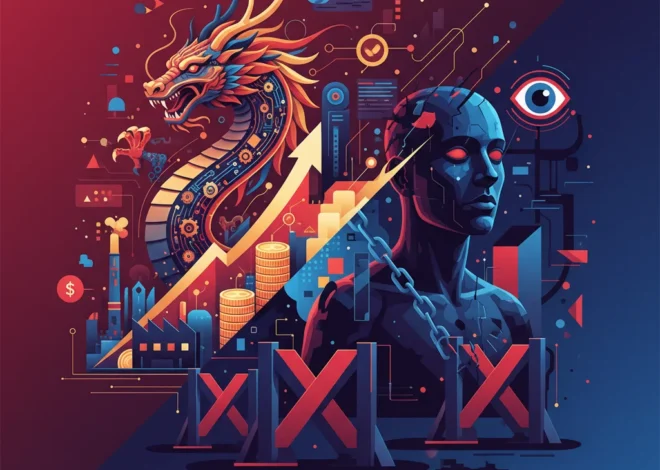
Beyond the Click: How AI in Advertising is Reshaping the Economy and Your Investment Portfolio
The Trillion-Dollar Question: Is AI the Future of Advertising or a “Creepy” Dead End?
In the relentless pursuit of consumer attention, a technological seismic shift is underway. Artificial Intelligence, once the domain of science fiction, is now the central engine of the global advertising industry. Major holding companies like WPP, the world’s largest advertising group, are betting billions on AI’s ability to craft the perfect, hyper-personalized message for every individual. The promise is a utopian vision of marketing: ads so relevant and helpful they cease to feel like ads at all. They become valuable services, anticipating our needs before we even articulate them.
However, a darker narrative is emerging from the digital ether. For every perfectly timed recommendation, there’s an ad that feels unnervingly prescient, a piece of creative that feels soulless and generic, or a campaign that simply misses the mark entirely. This is the world of “creepy slop,” a term that aptly captures the potential downside of AI-driven marketing—a deluge of algorithmically generated content that is invasive at best and nonsensical at worst. This dichotomy presents a critical challenge not just for marketers, but for business leaders, finance professionals, and investors. The way this tension resolves will have profound implications for corporate valuations, the digital economy, and the future of consumer trust.
The New Creative Engine: How AI is Powering Modern Advertising
To understand the financial stakes, we must first appreciate the depth of AI’s integration into the advertising workflow. This isn’t merely about automating banner ad placements; it’s a fundamental reimagining of the creative and strategic process.
At the forefront is Generative AI. Platforms like OpenAI’s DALL-E and Midjourney can produce stunning visuals from simple text prompts, while large language models (LLMs) can draft compelling ad copy in seconds. For global brands, this offers unprecedented scale and efficiency. As noted by one creative director, AI allows for the creation of thousands of ad variations tailored to different demographics, languages, and cultural contexts—a task that would have been prohibitively expensive and time-consuming for human teams. Nestle’s use of AI to generate images for its La Laitière yogurt brand is a prime example of this efficiency in action (source).
Beyond content creation, AI’s analytical prowess is revolutionizing targeting and optimization:
- Predictive Analytics: AI algorithms analyze vast datasets—browsing history, purchase behavior, social media activity—to predict which consumers are most likely to convert. This directly impacts the efficiency of ad spend and, consequently, a company’s bottom line.
- Real-Time Bidding (RTB): In the complex world of programmatic advertising, AI makes split-second decisions on which ad impressions to buy and how much to pay. This automated trading of ad space is a multi-billion dollar market, heavily reliant on machine learning.
- Performance Optimization: AI continuously A/B tests different ad creatives, headlines, and calls-to-action, reallocating budget to the best-performing variants in real-time, maximizing return on investment.
The implications for the stock market are clear. Companies that effectively harness this technology (like Meta and Google, whose ad engines are powered by sophisticated AI) can deliver superior returns for advertisers, solidifying their market dominance and driving shareholder value. Conversely, businesses that fail to adapt risk being outmaneuvered and losing market share.
Wall Street's Warning Bell: Is the US Financial System's Plumbing About to Clog Again?
The Economic Upside vs. The “Creepy Slop” Conundrum
The economic argument for AI in advertising is compelling. Increased efficiency lowers customer acquisition costs, boosts sales, and fuels corporate growth. This micro-level success aggregates into a significant driver for the broader digital economy. However, this progress is not without its perils. The path to personalization is fraught with ethical and practical challenges that can erode consumer trust and damage brand reputation.
The core of the problem lies in data. The hyper-personalization that AI promises requires vast amounts of personal information. As algorithms become more adept at connecting disparate data points, they can create consumer profiles that are, as Ogilvy’s chief creative officer for France, David Raichman, puts it, “a bit creepy” (source). When an ad seems to know about a private conversation or a fleeting, un-Googled thought, it crosses a line from helpful to invasive. This digital surveillance, even if used for benign commercial purposes, can lead to significant consumer backlash.
Furthermore, an over-reliance on AI can lead to a homogenized and uninspired creative landscape. If all brands are using the same models trained on the same data, we risk a future of “slop”—technically proficient but emotionally hollow advertising that fails to build any real brand connection. Below is a breakdown of the dual-edged nature of this technology.
| Aspect of AI Application | Potential for Value Creation (The Promise) | Potential for Value Destruction (The “Creepy Slop”) |
|---|---|---|
| Personalization & Targeting | Highly relevant offers, increased conversion rates, improved customer experience, higher ROI. | Invasive data collection, feelings of being watched, consumer backlash, erosion of trust. |
| Generative AI Content | Rapid, cost-effective creation of diverse ad creatives at scale for global campaigns. | Generic, soulless content, loss of brand voice, potential for factual errors or “hallucinations.” |
| Process Automation | Massive efficiency gains, reduced operational costs, faster campaign deployment. | Job displacement for creative professionals, risk of algorithmic bias, lack of human oversight. |
| Data Analysis | Deep consumer insights, accurate market forecasting, improved strategic decision-making. | Creation of filter bubbles, reinforcement of societal biases, risk of data breaches. |
Parallels in Financial Technology: A Lesson for Advertisers
The challenges facing the advertising industry are not unique. The world of finance, particularly financial technology (fintech) and banking, has been grappling with similar issues for years. Banks use AI to personalize loan offers, credit card recommendations, and investment advice. Algorithmic trading platforms use predictive models to execute transactions on the stock market at speeds no human could match.
The fintech sector provides a valuable case study. Successful platforms like Chime or Revolut have leveraged AI to create seamless, personalized user experiences. However, they operate in a highly regulated environment where mistakes have severe consequences. An algorithmic error in an ad campaign might lead to embarrassment; in banking, it could lead to discriminatory lending practices and massive regulatory fines. The financial industry has been forced to develop robust governance and “explainable AI” (XAI) models to ensure fairness and transparency. The ad industry would be wise to adopt a similar mindset before regulators force their hand.
The Billion-Dollar Blind Spot: Why the McDonald's Harassment Scandal is a Wake-Up Call for Investors
The Investor’s Compass: Navigating the AI Ad-Tech Revolution
For investors and business leaders, the rise of AI in advertising creates both opportunities and threats. Evaluating a company’s position in this new landscape requires looking beyond surface-level metrics.
- Data Governance and Ethics: Does the company have a clear, transparent policy on data collection and usage? A company that plays fast and loose with user data is a ticking time bomb of regulatory risk and reputational damage.
- The Human-in-the-Loop: The most effective strategies will not be purely AI-driven but will blend machine efficiency with human creativity and oversight. As one expert in the source article noted, AI should be a “tool to augment creativity, not replace it” (source). Look for companies that invest in training their creative talent to leverage AI effectively.
- Technological Infrastructure: A company’s ability to deploy AI at scale depends on its underlying tech stack. Investment in cloud computing, data processing capabilities, and proprietary algorithms are key indicators of a forward-looking strategy.
- Disruptive Technologies: Keep an eye on emerging technologies that could upend the current model. For instance, the principles of blockchain could lead to decentralized identity solutions, giving users direct control over their data. Such a shift would fundamentally alter the ad-tech landscape, creating new winners and losers for those engaged in long-term investing.
Conclusion: From “Slop” to Sophistication
The integration of AI into advertising is an irreversible trend with profound economic consequences. It holds the potential to unlock unprecedented efficiency and create more valuable, relevant experiences for consumers. However, the risk of creating an intrusive, uninspired digital world of “creepy slop” is very real. The ultimate trajectory will be determined not by the technology itself, but by the strategic and ethical choices made by the companies wielding it.
For investors, finance professionals, and business leaders, the key is to look beyond the hype. The crucial analysis lies in understanding which companies are using AI to build lasting relationships based on trust and value, and which are simply chasing short-term gains at the expense of their brand’s soul. The former are building the future of the digital economy; the latter are merely producing the noise that consumers will inevitably tune out.


